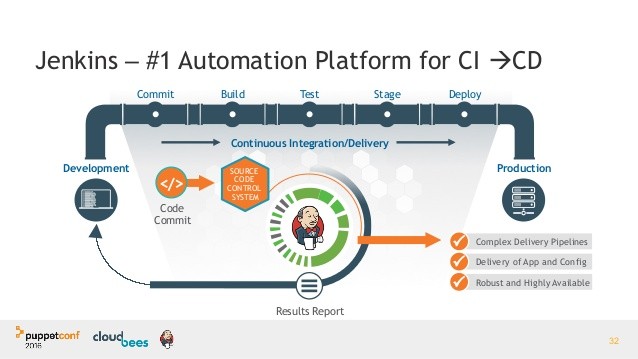
Automating Infrastructure with Puppet and Jenkins: A Powerful Combination
Jacob Bennett
SQL, Python, Power BI, AWS Data Engineer with 4+ years experience | Also experienced in Azure, GCP, Tableau, Microsoft Power Apps, Snowflake, Databricks, and general data science ????
In today's fast-paced IT landscape, automation is the key to maintaining efficiency, consistency, and reliability. Two tools that have become essential for achieving these goals are Puppet and Jenkins. Puppet excels in configuration management and automation, while Jenkins is a powerhouse for continuous integration and continuous delivery (CI/CD). When combined, these tools provide a robust framework for automating infrastructure and application deployment. This article explores the capabilities of Puppet and Jenkins, and how integrating them can transform your DevOps practices.
Puppet: Automating Configuration Management
Overview
Puppet is an open-source configuration management tool designed to automate the provisioning, configuration, and management of infrastructure. It enables system administrators and DevOps teams to define the desired state of their systems using declarative language.
Key Features
1. Declarative Language: Puppet uses its declarative language, Puppet DSL, which allows users to define system configurations in a human-readable format.
2. Idempotency: Puppet ensures that applying the same configuration multiple times results in the same system state, making it reliable and predictable.
3. Resource Abstraction: Puppet abstracts system resources, such as packages, services, and files, allowing the same code to be used across different operating systems.
4. Extensible Modules: Puppet Forge provides a vast repository of pre-built modules, enabling users to extend and customize their configurations easily.
5. Agent-Master Architecture: Puppet operates on an agent-master architecture, where the master node controls the configuration and the agent nodes apply it, ensuring centralized management.
Use Cases
- Server Configuration: Automating the setup and management of servers, ensuring consistency across environments.
- Application Deployment: Deploying applications with predefined configurations, reducing the risk of errors.
- Compliance Management: Enforcing security policies and compliance standards across the infrastructure.
Jenkins: Driving CI/CD Pipelines
Overview
Jenkins is an open-source automation server widely used for implementing CI/CD pipelines. It facilitates the process of building, testing, and deploying code, allowing teams to deliver software quickly and reliably.
Key Features
1. Pipeline as Code: Jenkins supports defining build, test, and deployment pipelines using code, typically in a Jenkinsfile, enabling version control and reproducibility.
2. Extensible Plugins: With over a thousand plugins available, Jenkins can be customized to fit any CI/CD workflow.
3. Distributed Builds: Jenkins supports distributed builds across multiple nodes, optimizing resource utilization and reducing build times.
4. Integration with Tools: Jenkins integrates seamlessly with various tools, including version control systems (e.g., Git), testing frameworks, and deployment tools.
领英推荐
5. Monitoring and Reporting: Jenkins provides real-time monitoring of builds and detailed reports, helping teams identify and resolve issues quickly.
Use Cases
- Continuous Integration: Automating the process of merging code changes and running tests to detect issues early.
- Continuous Delivery: Automating the deployment of applications to staging and production environments.
- Automated Testing: Running unit, integration, and performance tests as part of the CI/CD pipeline.
Integrating Puppet and Jenkins
Combining Puppet and Jenkins creates a powerful synergy that enhances automation across the entire software delivery lifecycle. Here’s how they can work together:
Continuous Deployment Pipeline
1. Code Commit: Developers commit code changes to a version control system (e.g., Git).
2. Build and Test: Jenkins detects the commit and triggers a build process. Automated tests are run to ensure code quality.
3. Configuration Management: Upon successful build and test, Jenkins triggers Puppet to apply the necessary configurations to the target environment.
4. Deployment: Jenkins deploys the application to the configured environment, whether it's a development, staging, or production server.
5. Monitoring and Feedback: Jenkins monitors the deployment and provides feedback. Any issues detected can trigger automated rollbacks or notifications to the development team.
Infrastructure as Code
Using Puppet’s declarative language and Jenkins’ pipeline capabilities, teams can manage their infrastructure as code:
1. Define Infrastructure: Use Puppet to define the desired state of infrastructure, including server configurations, network settings, and application dependencies.
2. Version Control: Store Puppet code in a version control system. Jenkins can monitor this repository for changes.
3. Automate Provisioning: Jenkins triggers Puppet to provision and configure infrastructure based on the defined state, ensuring consistency and reducing manual intervention.
4. Scalable Management: As infrastructure grows, Puppet and Jenkins can scale to manage hundreds or thousands of nodes efficiently.
Conclusion
Puppet and Jenkins are indispensable tools in the DevOps toolkit, each excelling in their respective domains of configuration management and CI/CD. When integrated, they provide a comprehensive solution for automating infrastructure and application deployment, enhancing efficiency, consistency, and reliability. By leveraging Puppet and Jenkins, organizations can streamline their DevOps practices, reduce errors, and accelerate their software delivery processes.
Embrace the power of automation with Puppet and Jenkins to stay ahead in the competitive landscape of modern IT.
Handel ( Xentric,Prime usw. ) und Kernbanksysteme ( OBS ) meine Welt ( Sybase / Informix )
7 个月Thx for dedicated information